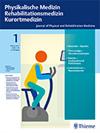颈椎疼痛、头前倾、无症状和非电脑使用者颈椎关节位置感的比较横断面研究
IF 0.5
4区 医学
Q4 REHABILITATION
Physikalische Medizin Rehabilitationsmedizin Kurortmedizin
Pub Date : 2021-11-28
DOI:10.1055/a-1916-0229
引用次数: 4
摘要
摘要目的人们每天在办公室和工作场所使用电脑进行不同的活动。受损的颈部本体感觉和前头部姿势(FHP)可能有助于计算机用户颈部疼痛的发展和维持。本研究的目的是:1)比较患有颈部疼痛的计算机用户、FHP、健康计算机用户和健康非计算机用户的颈关节位置感(JPS);2)评估颈关节位置觉与年龄、BMI、疼痛、残疾、头部姿势和计算机使用时间的关系。材料和方法这项横断面研究包括134名年龄在25至50岁之间的受试者,分为四组(第一组:患有颈部疼痛的计算机用户(n=31),第二组:患有FHP的计算机用户,n=33,第三组:健康计算机用户(n=35),第四组:健康非计算机用户(n=35)。使用颈椎活动范围装置在屈曲、伸展、左右旋转方向上评估颈椎JPS。重新定位精度被估计为以度为单位的关节位置误差(JPE)。两组之间的宫颈JPS进行比较,并与年龄、BMI、疼痛、残疾、头部姿势和计算机使用时间相关。结果与讨论颈痛组的平均颈部JPE显著增大(p0.05)。JPE与年龄、疼痛强度、残疾和计算机使用时间呈正相关。结论颈部疼痛和FHP的计算机使用者的颈部JPS明显受损。FHP、疼痛强度、残疾和计算机使用持续时间等因素可能会影响宫颈JPS,在评估和规划计算机专业人员的治疗策略时可以考虑这些因素。本文章由计算机程序翻译,如有差异,请以英文原文为准。
Comparison of Cervical Joint Position Sense in Computer Users with Neck Pain, Forward Head Posture, Asymptomatic and Non-Computer Users – A Cross-Sectional Study
Abstract Purpose People use computers in offices and workplaces daily to perform different activities. Impaired cervical proprioception and forward head posture (FHP) may contribute to the development and maintenance of neck pain in computer users. The aims of this study are 1) to compare cervical joint position sense (JPS) in computer users with neck pain, with FHP, healthy computer users, and healthy non-computer users, 2) to assess the relationship between cervical JPS and age, BMI, pain, disability, head posture, and duration of computer usage. Materials and Methods This cross-sectional study included 134 subjects aged between 25 to 50 years old in four groups (Group 1: computer users with neck pain (n=31), group 2: computer users with FHP (n=33), Group 3: healthy computer users (n=35), and Group 4: healthy non-computer users (n=35). The cervical JPS was evaluated in flexion, extension left and right rotation directions using a cervical range of motion device. The reposition accuracy is estimated as joint position error (JPE) in degrees. The cervical JPS is compared between groups and correlated with age, BMI, pain, disability, head posture, and duration of computer usage. Results and Discussion The mean cervical JPE's were significantly larger in the neck pain group (p<0.001) and in the FHP group (p<0.001) compared to other groups. There were no significant differences in JPE's between healthy computer users and non-users (p.>0.05). There was a significant positive correlation between JPE's and age, pain intensity, disability, and computer usage duration. Conclusion Computer users with neck pain and with FHP had significantly impaired cervical JPS. Factors like FHP, pain intensity, disability, and duration of computer usage may influence cervical JPS, and these factors can be considered when assessing and planning treatment strategies for computer professionals.
求助全文
通过发布文献求助,成功后即可免费获取论文全文。
去求助
来源期刊
CiteScore
1.10
自引率
25.00%
发文量
70
审稿时长
3 months
期刊介绍:
The Journal of Physical and Rehabilitation Medicine offers you the most up-to-date information about physical medicine in clinic and practice, as well as interdisciplinary information about rehabilitation medicine and spa medicine.
Publishing 6 issues a year, the journal includes selected original research articles and reviews as well as guidelines and summaries of the latest research findings. The journal also publishes society news and editorial material. “Online first” publication ensures rapid dissemination of knowledge.

 求助内容:
求助内容: 应助结果提醒方式:
应助结果提醒方式:


